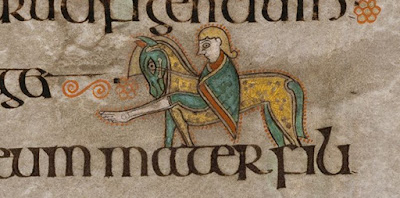Irish Horses
Horses in Ireland |
| Book of Kells f. 89r |
 |
| Book of Kells f.255v |
These imported horses were small, around 10 or 11 hands high (3), but the Irish bred them over the next two millennia to be slightly bigger, so that the horse bones of the Early Medieval Irish excavations average an estimated 13 hh (4). This was still a relative pony by comparison to the British horses (who may have been interbred with Roman horses to achieve their increased size). These small horses and work ponies were used for transportation, racing, and carrying small loads. In some cases ponies also pulled small wagons or carts, and chariots. The heavier wagons, and plows, were pulled primarily by oxen in Early Medieval Ireland. Horses were simply not big enough for heavier work.
The Irish laws therefore placed high value on imported breeding horses, who could be used to improve the size and speed of their ponies (5). With a constant influx of larger horses and deliberate breeding, the Irish managed to create a stronger, heavier horse appropriate for draft work, sometime during the Medieval period. In combination with the innovation of a collar and hames (a new form of harness that protected the windpipe and suprascapular nerve of the horse from damage when pulling heavy loads), this allowed horses to replace oxen as the plowbeasts of the day. Horses, once capable of pulling plows and heavy wagons, moved far faster than oxen; this meant that a farmer could get far more done with a team of draft horses than with a team of draft oxen, without much difference in hay needs.
 |
| Topographia Hiberniae f29r |
Women do not seem to have ridden horses very often in Ireland, although most rich men and lords rode frequently. Men rode without a saddle or stirrups, though they used a blanket over the back of the horse to protect themselves and their clothes from dirt and chaffing (6). The horse shoe was not introduced to Ireland until the eleventh century, so horses went barefoot in most of this period (7).
Sources:
1) McCormick, Finbar. “The horse in early Ireland.” Anthropozoologica 42, (1), p. 85-104. 2007. p. 85.
2) McCormick. “The horse in early Ireland.” p. 86.
3) McCormick. “The horse in early Ireland.” p. 87.
4) McCormick. “The horse in early Ireland.” p. 88.
5) Kelly. Early Irish Farming. p. 90.
6) Kelly. Early Irish Farming. p. 98.
7) McGrath, Mary and Joan Griffith, ed. The Irish Draught Horse: A History. Collins, 2005. p. 33.
Comments
Post a Comment
Questions and suggestions for further research are welcome. No selling, no trolling, and back up any critique with modern scholarly sources. Comments that do not meet these criteria will be discarded.